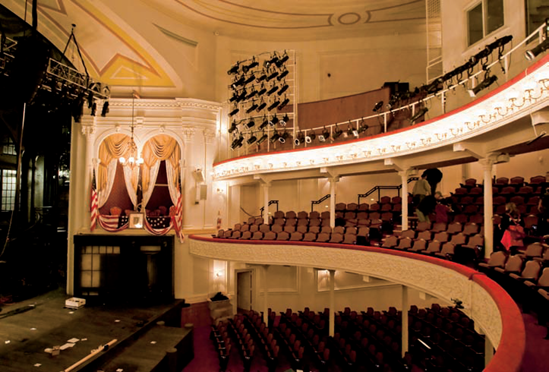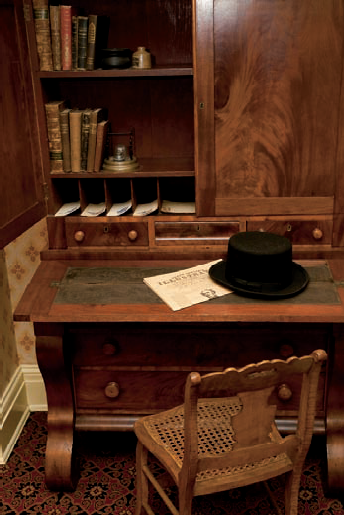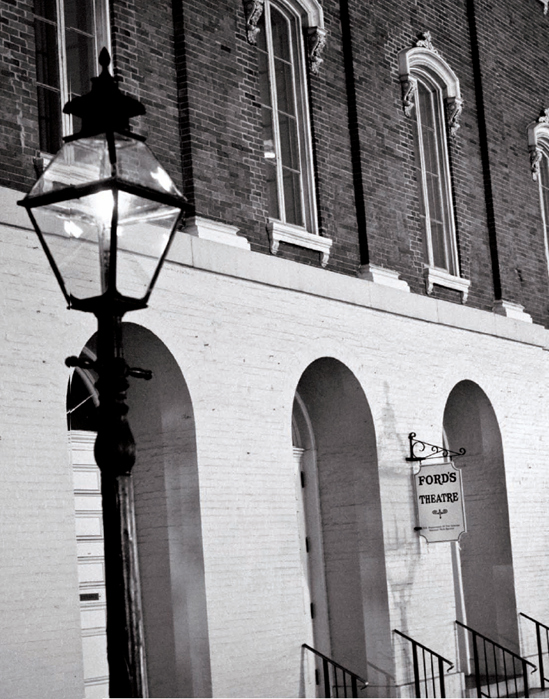
Ford's Theatre seen from along 10th St NW. Taken at ISO 3200, f/4 1/40 second with a 50mm lens.
Originally known as Ford's Athenaeum, this theater in downtown Washington, D.C., is remembered for a singular tragic event — the assassination of President Abraham Lincoln on April 14, 1865. John Wilkes Booth, a famous actor and staunch supporter of slavery and the Confederacy, shot President Lincoln in the back of his head during a play at Ford's Theatre. President Lincoln died the next morning at 7 a.m. in the Petersen House across the street.
The Petersen House is preserved and furnished with artifacts from the time. It's a small, narrow space where you can see the home's parlor, living area, and the room in which President Lincoln died.
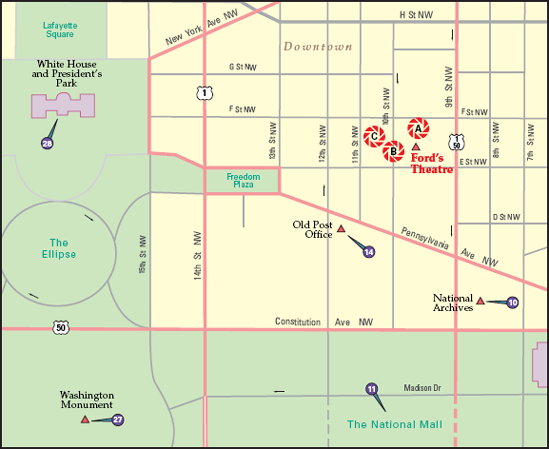
Figure 3.1. The best locations from which to photograph Ford's Theatre: (A) interior of Ford's Theatre, (B) exterior of Ford's Theatre on 10th St. NW, and (C) interior of Petersen House. Nearby photo ops: (10) National Archives, (11) National Mall, (14) Old Post Office, (27) Washington Monument, and (28) White House and President's Park.
You can get great photos of Ford's Theatre both inside and out. For capturing images of the room where Lincoln died, visit Petersen House across the street.
If there is one photo from Ford's Theatre that you must take, it is the image of the Presidential Box where Lincoln was shot (see Figure 3.1).
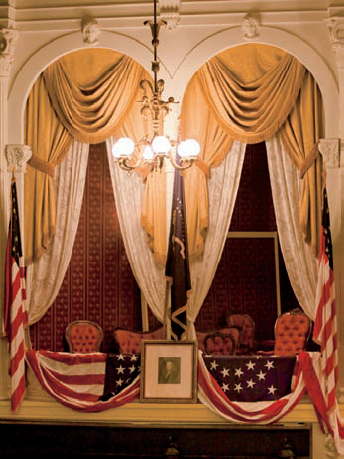
Figure 3.2. The Presidential Box photographed from the opposite side of the theater's balcony (see A on the map). Taken at ISO 3200, f/2.8, 1/125 second with a 90mm lens.
You can participate in a group walkthrough of the museum and balcony, which takes you first to the museum below the theater and then to the balcony of the theater. From here, you can see the Presidential Box as well as the entirety of the theater from the balcony (see Figure 3.2).
Along 10th St. NW, you can get a good sidelong view of the front of Ford's Theatre (see Figure 3.3).
The sidewalk in front of Ford's Theatre offers a few good opportunities to photograph the building, as well. Gas lamps and vintage-looking signs in front of the theater (see Figure 3.4) add a little old-world charm to the block that has little of its original appearance left.
Visitors to the Petersen House use their ticket from Ford's Theatre for a quick five-minute walkthrough of a few rooms to see what the home looked like when Lincoln died (see figures 3.5 and 3.6).
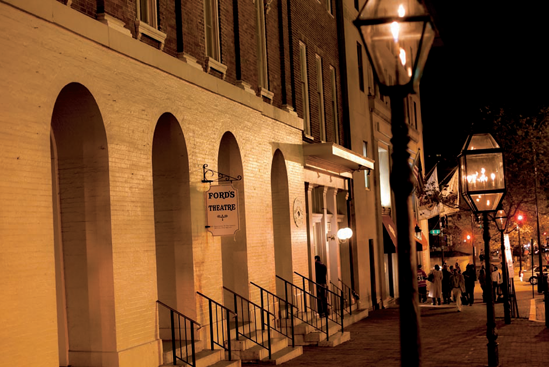
Figure 3.4. A view of Ford's Theatre from 10th St. NW at night (see B on the map). Taken at ISO 1600, f/2, 1/60 second with a 65mm lens.
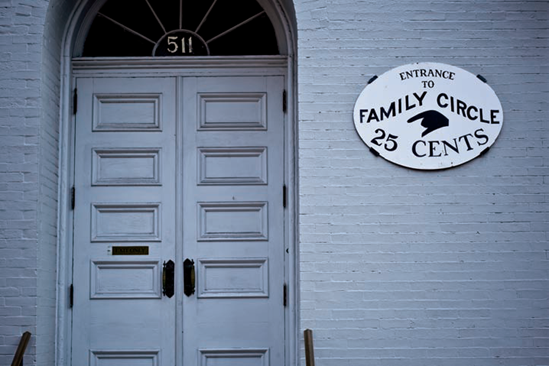
Figure 3.5. A detail from the front of Ford's Theater (see B on the map). Taken at ISO 100, f/4, 1/400 second with a 65mm lens.
The following sections provide a few tips for taking photos at Ford's Theatre and Peterson House, which are dimly-lit places with limited space to move about.
There are two general requirements for taking good photos: space and light. Space is good so that you are able to explore different angles and get a variety of images. Light is good so you can take pictures of decent quality. Inside Ford's Theatre and in the Petersen House, both are constrained to a certain degree.
Inside the theater, you want to use about a 70–100mm lens to photograph the Presidential Box from across the theater. There are other vantage points from which to do this, but straight across affords the cleanest view. Taking a wide photo, one in which you see the lines of the theater's balcony, is another option.
Inside of the Petersen House (see Figure 3.7), you need a fairly wide lens of between 20–35mm, up to a standard 50mm. Interiors look awfully strange when photographed with ultra-wide lenses, so it's often a good idea to stand as far back as you can and use the longest lens possible to minimize lens distortion.
You'll notice that within this book, there has been very little talk of flash. The reason is simple: Flash is pretty difficult to master. And using an on-camera flash is a prescription for ugly photos 90 percent of the time. However, to get photographs that were good enough to be used in this book, I resorted to using flash for the Petersen House because it is so dark.

Figure 3.8. The bedroom where President Lincoln died (see C on the map). Taken at ISO 2000, f/4, 1/50 second with a 35mm lens and a flash bounced off the ceiling.
I used an accessory flash on my camera that allowed me to aim it at the ceiling, rather than straight at the subject. Why the ceiling? Because direct flash — that is, flash that comes straight from the camera onto the subject — is unflattering. (Think of how good a deer looks in a car's headlights; it's the same effect with on-camera flash.) To get around this, I pointed the flash upward and let it bounce off the white ceiling. This achieves three things:
It softens the harsh light coming from the flash by diffusing it off the ceiling.
It redirects the light to come from a more natural angle.
It broadens the light so that it fills more of the space.
Built-in flashes can't do any of that because they don't angle upward. Many accessory flashes have heads that rotate and swivel for this purpose.
Amazing advances in sensor technology are allowing for ISO speeds far beyond the traditional limits of 3200 or even 6400. The newest cameras have ISO speeds of over 100,000, meaning flash will become even rarer because it simply won't be needed in many cases.
Inside Ford's Theatre, you want to have your ISO set as high as possible. Using your on-camera flash won't do kind things to the photograph of the Presidential Box (see Figure 3.1), so unless you have to use it (because your camera doesn't have a high enough ISO setting or the image quality isn't good enough when the ISO is set high), turn it off.
Be sure to use a fast-enough shutter speed to avoid camera shake. If you have a new camera that has very high ISO speeds, the lack of light inside here will be less of a problem. Otherwise there is just enough light here to handhold a camera and get some good shots. Using a monopod could also help to stabilize your lens, or you could brace your hands against the top of a seat or nearby wall.
Holding a camera completely still below 1/30 second is not easy, but it's okay to try if it's needed. Using anything below 1/10 second is not recommended. The photo will almost certainly be blurry.
Outside the theater, shooting is much easier. You can use an Auto, Shutter Priority, or Aperture Priority mode, and concentrate on good composition. Be sure to set your focus on what is most important: the building, rather than any foreground elements you may choose to use in your composition.
In the Petersen House (see Figure 3.8), try setting your camera to an automatic mode and, if you're using an accessory flash, point it up at the ceiling. Most cameras that can use an accessory flash will automatically set the flash exposure to work with the flash pointed at the ceiling. (This assumes that you are using an accessory flash that is designed to work with your specific model of camera and can utilize its automatic flash feature.)
Things can get rather complicated quickly here, but a simple way to start is to set up your camera to let in a lot of light, such as 1/30 second at f/4 at ISO 1600. Then turn on your flash and see how the images come out. If the images are too bright, turn down your flash's power until they seem exposed correctly (if your flash enables you to manually change its power settings). If you can't control the flash's power, try raising the aperture value to a higher setting, which can help control the brightness of the flash exposure.
Because most of these images are indoors, you want to avoid big crowds and buses of students.

Figure 3.9. A replica of President Lincoln's deathbed (see C on the map). Taken at ISO 2000, f/4, 1/40 second at with a 20mm lens and a flash bounced off the ceiling.
I recommend calling ahead and asking about good times to visit. Early in the week and early in the morning are the standard times when fewer people are here, however. Also, keep in mind that Ford's Theatre is a working theater, so you have to plan your trip around show dates. See www.fordstheatre.org for more information on when to visit.
Night shots of the exterior of Ford's Theatre are nice because of the gas lamps and the interesting look night gives to any photo. However, the tours of Ford's Theatre and Petersen House are only given during mostly daylight hours, so you won't be able to make any interior photographs at night.

